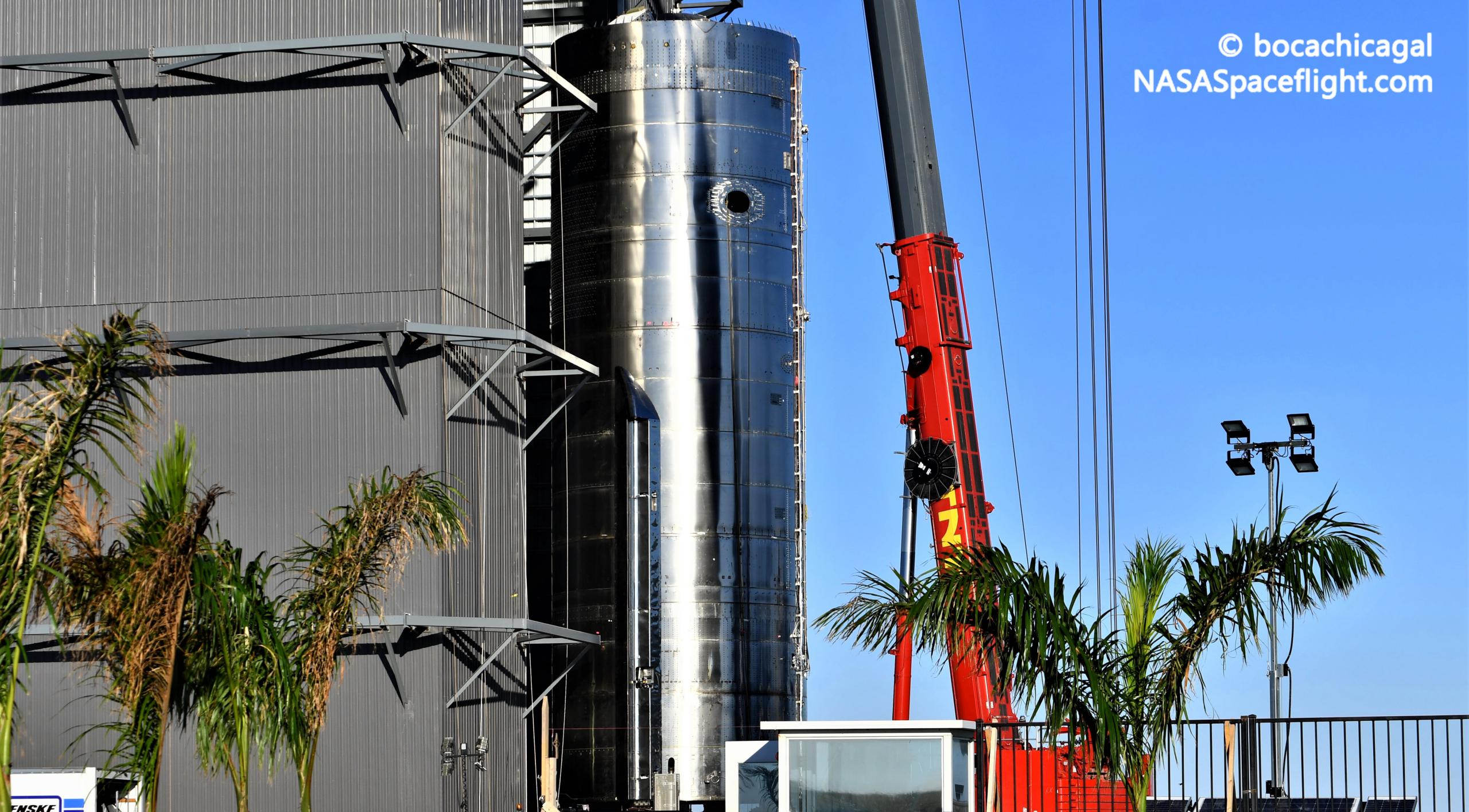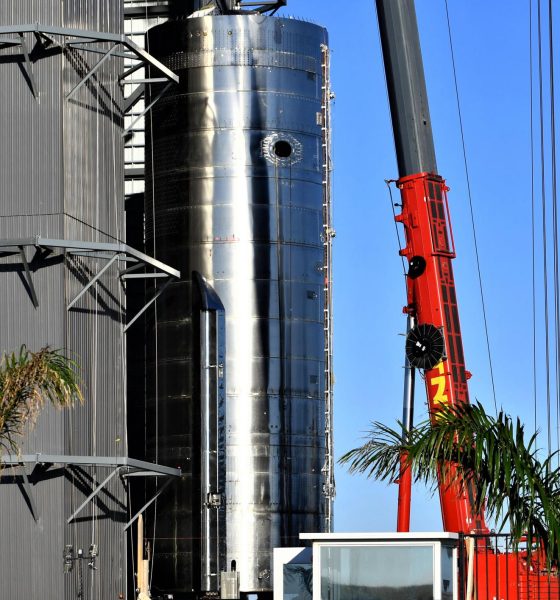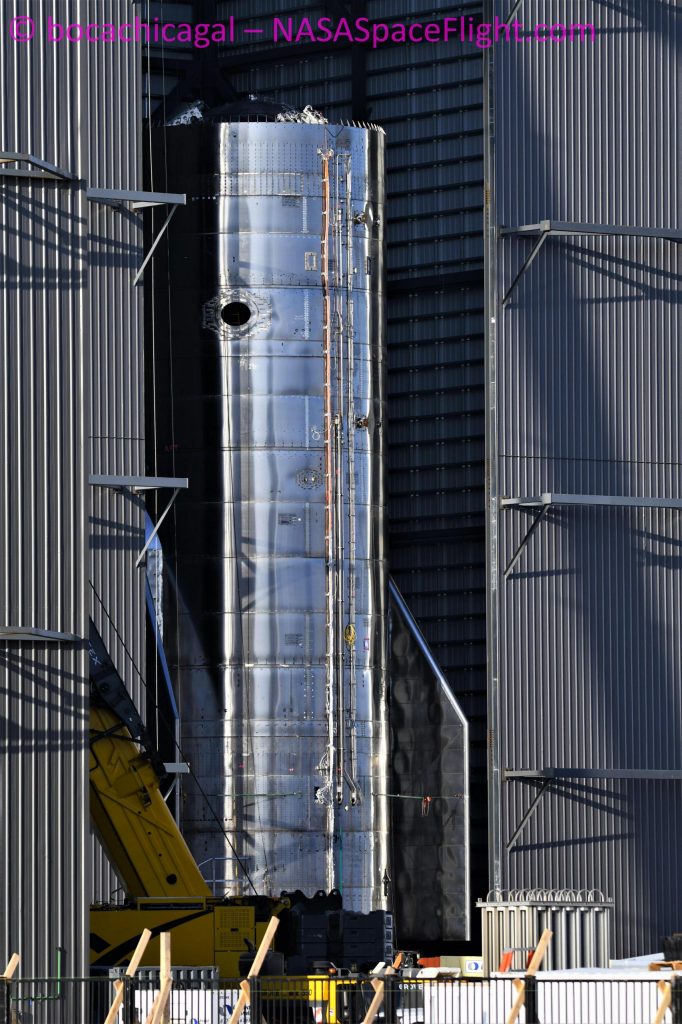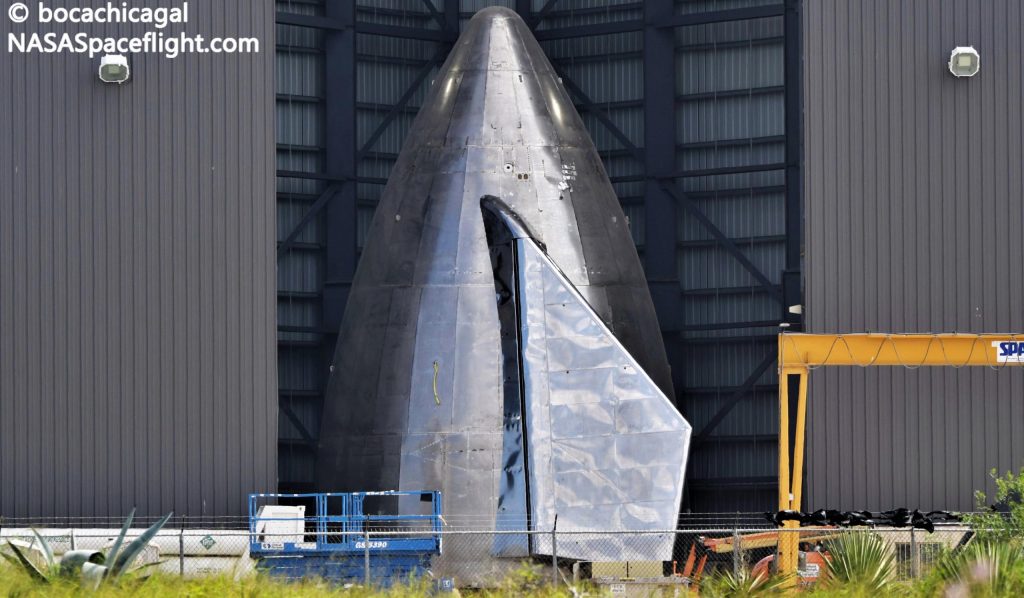

News
SpaceX’s next two Starships close behind first high-altitude rocket
SpaceX is in the midst of preparing Starship serial number 8 (SN8) for the first high-altitude launch of its kind – a test that could easily end in a fireball. To counter that risk, SpaceX is doing what it does best: building a fleet of prototypes as quickly as possible.
Currently sitting at the launch pad in anticipation of its first fully-integrated cryogenic proof and triple-Raptor static fire test(s), Starship SN8 was expected to begin that test campaign on Sunday, November 1st, followed by 9am to 11pm windows on Monday, Tuesday, and Wednesday. With about three hours left in Monday’s window, SpaceX appears to have delayed Starship SN8’s next round of tests for unknown reasons, though new road closures on the 5th and 6th were requested as recently as today.
Given that Starship SN8 is the first full-scale prototype to have three Raptors and a functional (and plumbed) nose section installed, some slack is warranted. Crucially, though, as teams prepare SN8 for what could be an explosive flight debut, SpaceX’s Boca Chica factory continues to churn out replacement prototypes just a few miles down the road.

Most recently, Starship SN10’s tank and engine section was fully stacked on November 2nd, completing the cylindrical structure that functions as the rocket’s airframe, propellant tanks, and engine mounts. The only major work that remains is completing minor external and internal plumbing, fully installing avionics, and finally installing the ship’s ‘aero covers’ and flaps. Once completed, a nosecone – also fitted with two flaps – will be stacked on four or five steel rings and then installed on top of the rest of the rocket.


A few weeks ahead of SN10, Starship SN9 is crossing exactly those milestones. On October 31st, SpaceX moved the rocket’s completed tank section into the nearly completed high bay where Super Heavy boosters will soon be built. Large aft flaps were then lifted and installed on the side of the ship, essentially leave just two steps left before Starship SN8 will have a 1:1 replacement ready to go.
Now the only thing missing from SN9 is a nose section (and Raptors, technically). Work on that nose section is already partially complete, with a stack of five steel rings already more or less ready for its nosecone ‘hat’ as of November 1st.


An SN9-specific nosecone has yet to be spotted but may well be hiding – completed – just behind the closed doors of SpaceX’s nose production tent. Ultimately, pass or fail, SpaceX’s consistently hardware-rich and iterative approach to development means that Starship SN8’s launch debut will produce useful data and help point out any pressing upgrades or fixes in need of immediate implementation. At the moment, SN8’s launch date is completely up in the air but will likely solidify as the rocket (hopefully) proceeds through several upcoming tests.

News
Tesla starts showing how FSD will change lives in Europe
Local officials tested the system on narrow country roads and were impressed by FSD’s smooth, human-like driving, with some calling the service a game-changer for everyday life in areas that are far from urban centers.

Tesla has launched Europe’s first public shuttle service using Full Self-Driving (Supervised) in the rural Eifelkreis Bitburg-Prüm region of Germany, demonstrating how the technology can restore independence and mobility for people who struggle with limited transport options.
Local officials tested the system on narrow country roads and were impressed by FSD’s smooth, human-like driving, with some calling the service a game-changer for everyday life in areas that are far from urban centers.
Officials see real impact on rural residents
Arzfeld Mayor Johannes Kuhl and District Administrator Andreas Kruppert personally tested the Tesla shuttle service. This allowed them to see just how well FSD navigated winding lanes and rural roads confidently. Kruppert said, “Autonomous driving sounds like science fiction to many, but we simply see here that it works totally well in rural regions too.” Kuhl, for his part, also noted that FSD “feels like a very experienced driver.”
The pilot complements the area’s “Citizen Bus” program, which provides on-demand rides for elderly residents who can no longer drive themselves. Tesla Europe shared a video of a demonstration of the service, highlighting how FSD gives people their freedom back, even in places where public transport is not as prevalent.
What the Ministry for Economic Affairs and Transport says
Rhineland-Palatinate’s Minister Daniela Schmitt supported the project, praising the collaboration that made this “first of its kind in Europe” possible. As per the ministry, the rural rollout for the service shows FSD’s potential beyond major cities, and it delivers tangible benefits like grocery runs, doctor visits, and social connections for isolated residents.
“Reliable and flexible mobility is especially vital in rural areas. With the launch of a shuttle service using self-driving vehicles (FSD supervised) by Tesla in the Eifelkreis Bitburg-Prüm, an innovative pilot project is now getting underway that complements local community bus services. It is the first project of its kind in Europe.
“The result is a real gain for rural mobility: greater accessibility, more flexibility and tangible benefits for everyday life. A strong signal for innovation, cooperation and future-oriented mobility beyond urban centers,” the ministry wrote in a LinkedIn post.
News
Tesla China quietly posts Robotaxi-related job listing
Tesla China is currently seeking a Low Voltage Electrical Engineer to work on circuit board design for the company’s autonomous vehicles.

Tesla has posted a new job listing in Shanghai explicitly tied to its Robotaxi program, fueling speculation that the company is preparing to launch its dedicated autonomous ride-hailing service in China.
As noted in the listing, Tesla China is currently seeking a Low Voltage Electrical Engineer to work on circuit board design for the company’s autonomous vehicles.
Robotaxi-specific role
The listing, which was shared on social media platform X by industry watcher @tslaming, suggested that Tesla China is looking to fill the role urgently. The job listing itself specifically mentions that the person hired for the role will be working on the Low Voltage Hardware team, which would design the circuit boards that would serve as the nervous system of the Robotaxi.
Key tasks for the role, as indicated in the job listing, include collaboration with PCB layout, firmware, mechanical, program management, and validation teams, among other responsibilities. The role is based in Shanghai.
China Robotaxi launch
China represents a massive potential market for robotaxis, with its dense urban centers and supportive policies in select cities. Tesla has limited permission to roll out FSD in the country, though despite this, its vehicles have been hailed as among the best in the market when it comes to autonomous features. So far, at least, it appears that China supports Tesla’s FSD and Robotaxi rollout.
This was hinted at in November, when Tesla brought the Cybercab to the 8th China International Import Expo (CIIE) in Shanghai, marking the first time that the autonomous two-seater was brought to the Asia-Pacific region. The vehicle, despite not having a release date in China, received a significant amount of interest among the event’s attendees.
Elon Musk
Elon Musk and Tesla AI Director share insights after empty driver seat Robotaxi rides
The executives’ unoccupied tests hint at the rapid progress of Tesla’s unsupervised Robotaxi efforts.

Tesla CEO Elon Musk and AI Director Ashok Elluswamy celebrated Christmas Eve by sharing personal experiences with Robotaxi vehicles that had no safety monitor or occupant in the driver’s seat. Musk described the system’s “perfect driving” around Austin, while Elluswamy posted video from the back seat, calling it “an amazing experience.”
The executives’ unoccupied tests hint at the rapid progress of Tesla’s unsupervised Robotaxi efforts.
Elon and Ashok’s firsthand Robotaxi insights
Prior to Musk and the Tesla AI Director’s posts, sightings of unmanned Teslas navigating public roads were widely shared on social media. One such vehicle was spotted in Austin, Texas, which Elon Musk acknowleged by stating that “Testing is underway with no occupants in the car.”
Based on his Christmas Eve post, Musk seemed to have tested an unmanned Tesla himself. “A Tesla with no safety monitor in the car and me sitting in the passenger seat took me all around Austin on Sunday with perfect driving,” Musk wrote in his post.
Elluswamy responded with a 2-minute video showing himself in the rear of an unmanned Tesla. The video featured the vehicle’s empty front seats, as well as its smooth handling through real-world traffic. He captioned his video with the words, “It’s an amazing experience!”
Towards Unsupervised operations
During an xAI Hackathon earlier this month, Elon Musk mentioned that Tesla owed be removing Safety Monitors from its Robotaxis in Austin in just three weeks. “Unsupervised is pretty much solved at this point. So there will be Tesla Robotaxis operating in Austin with no one in them. Not even anyone in the passenger seat in about three weeks,” he said. Musk echoed similar estimates at the 2025 Annual Shareholder Meeting and the Q3 2025 earnings call.
Considering the insights that were posted Musk and Elluswamy, it does appear that Tesla is working hard towards operating its Robotaxis with no safety monitors. This is quite impressive considering that the service was launched just earlier this year.








